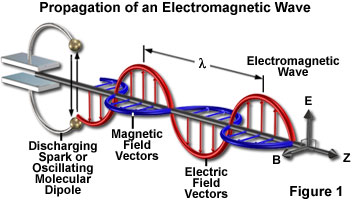Visible light, X-rays , sunlight, radio waves, television waves, wifi signals, blue tooth signals, cell phone transmission and GPS. All are purely electromagnetic waves made up of electric and magnetic fields. We just want to know how they are created and propagated.
Imagine a positive and negative charges separated by a distance. An invisible line of electric force connects both of them. If we oscillate one of the charges, line of force oscillates and creates a wave like form. ( If you oscillate a rope tide at one end, a wave ripples through the rope)
That is, electric field oscillates or changes with time. According to Maxwell's fourth law, a changing electric field produces changing magnetic field perpendicular to it and encircling it. So a magnetic field wave is produced.
Again Maxwell's third law says, "changing magnetic field produces circulating electric field".
So the result is : The oscillating charges produce changing electric field; changing electric field creates changing magnetic field; then changing magnetic field .... so on and on.
Hence electromagnetic field is created and propagates through empty space by itself. Maxwell proved the existence of electromagnetic wave and he also proved that they travel with the velocity of light using purely mathematics (without doing any experiment).
A star light travels number of years in space before reaching our eyes. This kind of self sustaining motion is possible because of Maxwell's electromagnetic phenomenon.

